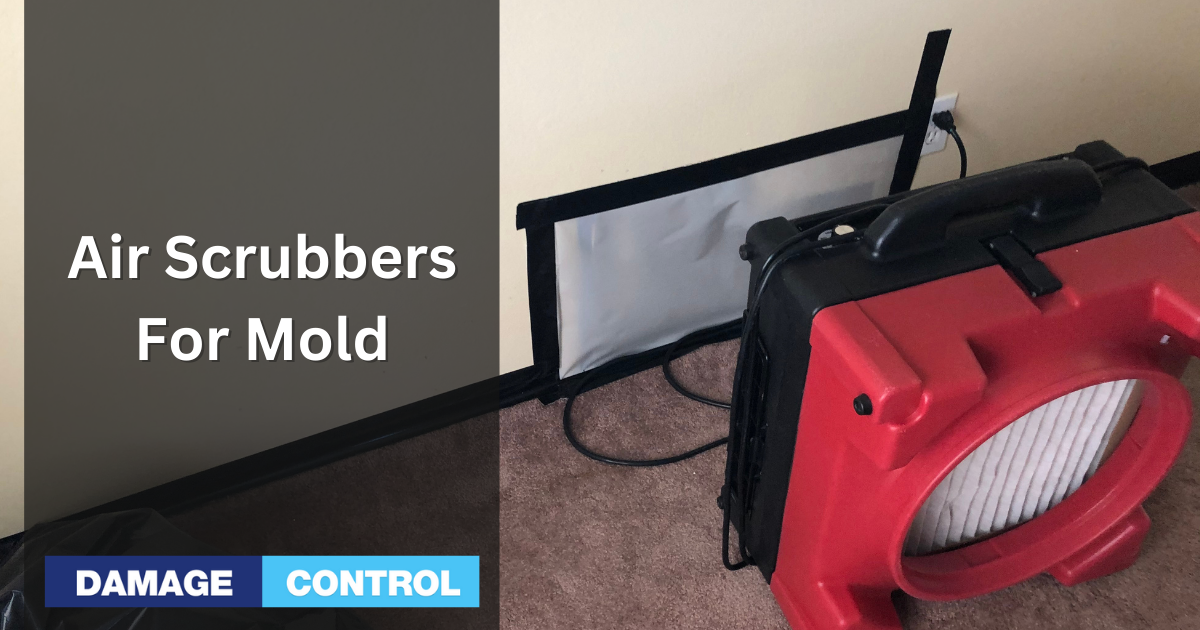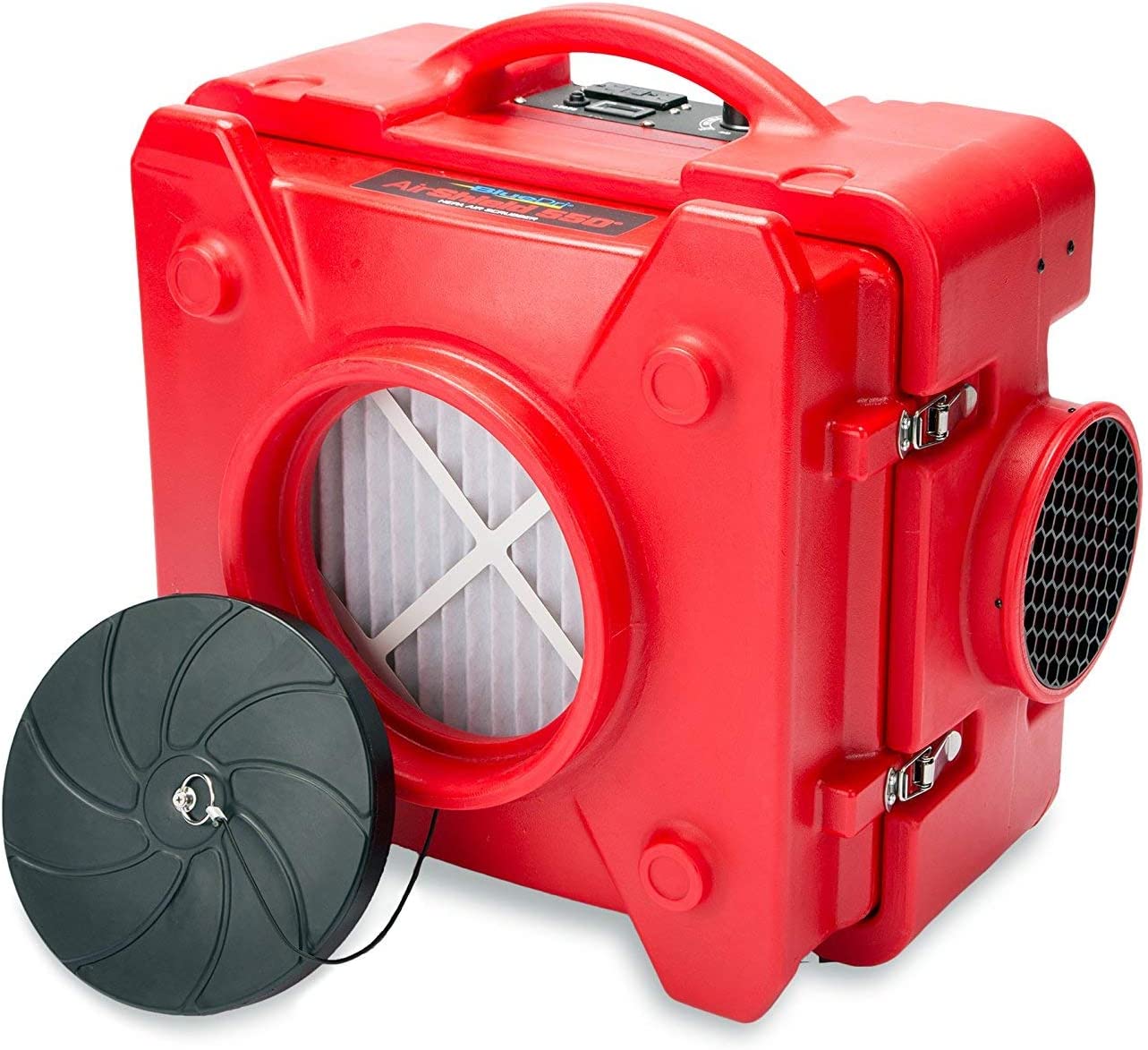An air scrubber can be a valuable tool when tackling mold removal projects. They work by filtering out airborne particles, such as spores that may cause health problems if left untreated.
Using an air scrubber during a mold remediation project can provide numerous benefits, including improved indoor air quality and reduced risk of further contamination or spread of the existing problem.
Professional services are available to help you understand all aspects of using an air scrubber for mold so you can ensure your family remains safe from any potential hazards caused by contaminated environments.
Read on to learn more about what an air scrubber is, how it works, its many benefits, the different types used for various applications, and how professional services can assist with successful results!
Are you searching for air scrubbers to purchase?
Visit our buying guide to view a list of the most used air scrubbers for mold remediation.
What is an Air Scrubber?
An air scrubber is a device used to filter and purify the air in an indoor environment. It works by drawing in contaminated air, trapping particles, and releasing clean air into the environment.
Air scrubbers are commonly used for mold remediation projects as they can effectively remove airborne mold spores from the environment.
What Are the Different Types of Air Scrubbers?
There are 3 types of air scrubbers, each with its own unique benefits and drawbacks.
Dry Scrubber
A dry air scrubber can also be called an air purifier because it pulls air in through at least one filter and then pushes the clean air out of the system.
Commercial dry air scrubbers, such as this one made by BlueDri on Amazon, will use multiple filters, each most effective for a single type of particulate matter. You'll almost always find a HEPA filter designed to capture small particles inside a commercial dry air scrubber.
The machine pictured above by BlueDri uses 3 filter stages: a pre-filter for large particles, an optional carbon filter for odors, and a HEPA filter for fine particulates.
Dry air scrubbers are also known as negative pressure machines.
Wet Scrubber
Wet air scrubbers use a fine mist to bind to particles and filter them out of the air. These machines are more complex than dry scrubbers due to the need for a water pump, fan, ductwork, and other components.
This is not the type of air scrubber used in residential or commercial mold remediation; they are used in industrial operations to clean the pollution produced by the facility.
Integrated Scrubber
An integrated air scrubber is designed for your existing HVAC system. Most homes don't have this, but you should consider installing this upgrade to help filter the air in your home.
How Does an Air Scrubber Work?
It works by drawing in contaminated air, passing it through filters and other components, and then releasing clean air into the environment. The process of using an air scrubber for mold remediation is effective at reducing airborne mold spores and improving indoor air quality.
Overview of the Process
Air scrubbers are designed to capture particles as small as 0.3 microns from the surrounding environment. They use fans or blowers to draw in contaminated indoor air, which passes through multiple layers of filtration before being released back into the room.
Depending on the unit type, this may include HEPA filters, activated carbon filters, UV lights, or ozone generators that help reduce odors and improve air quality.
The Role of Air Filters in the Process
The primary purpose of an air scrubber’s filter system is to capture airborne particles such as dust mites, pollen grains, pet dander, and even bacteria and viruses that can cause health problems if inhaled over time.
High-efficiency particulate arresting (HEPA) filters are most commonly used because they have been proven to be 99% effective at capturing particles down to 0.3 microns in size – making them ideal for removing mold spores from your home’s atmosphere.
In addition to filtering out harmful particles from your home’s atmosphere with HEPA filters, some units also feature ultraviolet (UV) light technology, which helps kill off any remaining microbes or allergens within your living space after filtration.
This added layer of protection ensures that you will have cleaner breathing conditions and fewer chances for future contamination due to lingering microorganisms left behind after cleaning up water damage or dealing with black mold growth issues inside your home.
Ultraviolet (UV) Lights
Some air scrubbers use UV lighting as a method of killing microorganisms.
They emit ultraviolet radiation, which is lethal for many microorganisms, including fungi such as black mold spores; this makes them ideal for use in areas where visible signs of fungal growth have been identified but cannot easily be reached using traditional cleaning methods.
This type of technology is great when you can't reach the surface to clean it with disinfectant, such as in air ductwork.
An air scrubber is an important tool for mold remediation, as it helps to reduce the risk of health issues related to mold exposure and improve indoor air quality. The next section'll explore the benefits of using an air scrubber for mold remediation.
What Are the Benefits of Using an Air Scrubber for Mold Remediation?
The primary benefit of using an air scrubber for mold remediation is reduced risk of health issues related to mold exposure. Mold spores are microscopic organisms that float through the atmosphere undetected until they land on damp surfaces, where they grow rapidly into colonies known as mildew.
If left unchecked over time, this growth can cause serious respiratory problems, including coughing, sneezing, wheezing, shortness of breath, headaches, skin irritation, eye irritation, sinus congestion, fatigue, nausea, vomiting, dizziness, fever, sore throat, chest tightness, asthma exacerbation, bronchitis, pneumonia, and allergic reactions, among others.
An effective way to prevent these symptoms is by using an air scrubber with HEPA filters, which capture up 99% percent of all particles larger than 0 3 microns, thus reducing your chances of exposure to harmful mold spores indoors.
Another benefit of using an air scrubber during your mold remediation project is that you're not only removing mold spores from the air. It also captures and removes airborne pollutants, such as dust mites and other allergens, which can trigger asthma attacks or allergies in some people.
Additionally, it helps eliminate odors caused by smoke or cooking fumes, which can make any room feel stuffy or unpleasant. Regular use of an air scrubber will show a marked improvement in your indoor environment’s overall cleanliness level and smell.
How Can Professional Services Help with Mold Remediation Projects?
Professional services can help with mold remediation projects in a variety of ways. Assessing the extent of damage and identifying sources of contamination is one way that professionals can assist. This involves inspecting the area, taking samples, and analyzing them to determine what mold is present and how much has spread throughout the home.
Professionals also have access to specialized equipment such as air scrubbers, HEPA filters, negative pressure machines, ozone generators, and ultraviolet (UV) lights, which are used to remove airborne particles from the air or surfaces.
Developing a plan for remediation and restoration is another important step that should be taken when dealing with mold growth in your home. Professionals will assess the situation and recommend appropriate action based on their findings.
This may include removing any affected materials, such as drywall or carpeting, cleaning all surfaces, applying anti-fungal solutions, sealing off areas where moisture could enter, installing dehumidifying systems, or replacing insulation.
FAQs about Air Scrubbers for Mold
Do air scrubbers work for mold?
Yes, air scrubbers can effectively capture mold spores from the air. Air scrubbers use a combination of filtration and negative pressure to capture airborne particles such as mold spores.
The filter within the machine captures the particles, while the negative pressure helps draw contaminated air into the unit for cleaning. This process is repeated until all mold spores have been removed from your home's indoor environment.
Regular maintenance and proper operation allow an air scrubber to reduce or eliminate black mold growth in your home.
Do the air scrubbers work?
Yes, air scrubbers do work. They are designed to remove airborne particles, such as mold spores and other contaminants that can cause health problems.
Air scrubbers use a combination of filters and fans to capture these particles and trap them in the filter media before they can be released back into the environment. This helps reduce levels of indoor pollutants, which is important for maintaining healthy indoor air quality.
How long to run an air scrubber for mold?
The time to run an air scrubber for mold remediation depends on the size and severity of the infestation. Generally, it is recommended that an air scrubber be used for at least 24 hours in a room with visible mold growth.
Running the machine for 48-72 hours may be necessary if there is heavy contamination. Ensuring all areas are properly treated and monitored throughout the process is important.
Additionally, any porous materials should be removed or replaced as they can harbor spores even after completed treatment.
Can you filter mold out of the air?
Yes, it is possible to filter mold out of the air. Air filtration systems can capture and remove airborne mold spores from a home or other indoor environment. These systems typically use permanent (saves you money in the long term) high-efficiency particulate arrestance (HEPA) filters designed to trap particles as small as 0.3 microns in size, including mold spores.
Additionally, some types of air purifiers may utilize ultraviolet light technology or even ozone to kill airborne mold spores before they have a chance to settle on surfaces and cause further damage. The additional benefit of ozone is that it kills mold spores and destroys the odors where HEPA filters fail.
Conclusion
Professional services are available to help with the process, ensuring your home is safe from further damage and contamination. With their expertise, they can determine the best type of air scrubber for your situation and guide you on properly using it.
Utilizing an air scrubber for mold remediation will improve indoor air quality and give you peace of mind, knowing that you have taken steps to protect yourself and your family from potential health risks associated with black mold growth.


